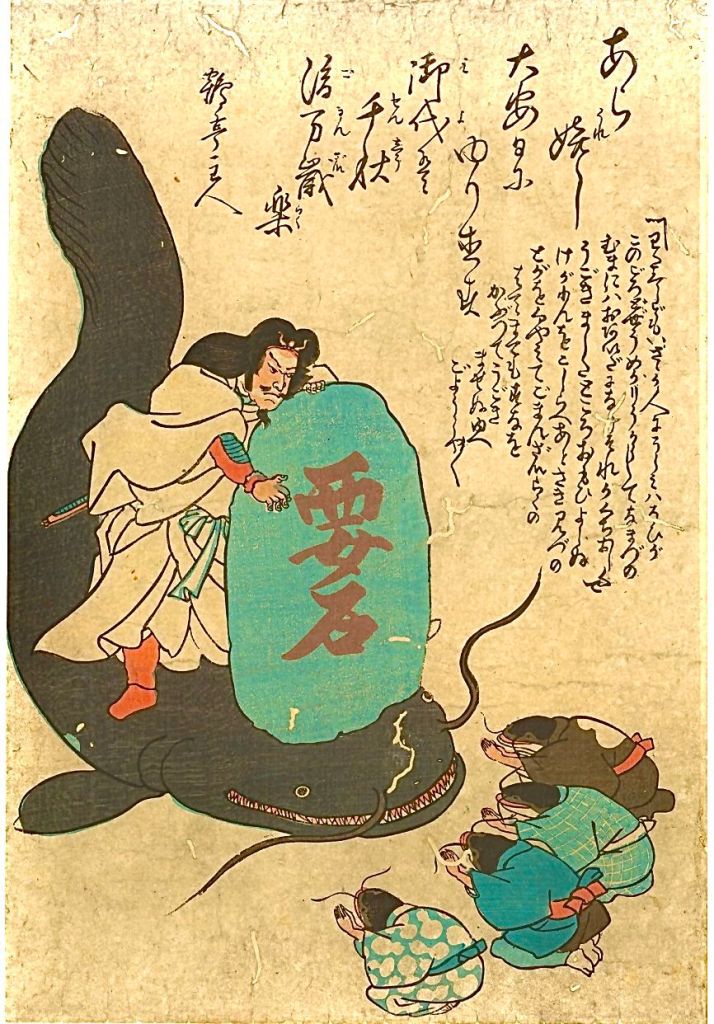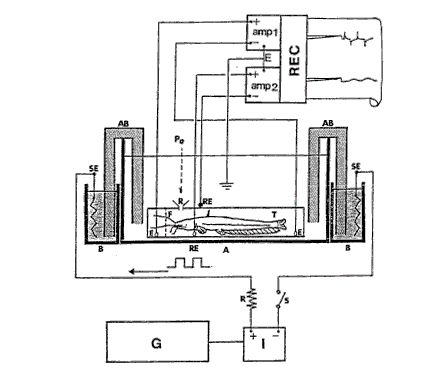When you hear the word “catfish,” what comes to mind? In Japan, there are many lore surrounding them.
In Japan, there are multiple species of catfish, but in this article, catfish refers to the Japanese catfish, known as Nihonnamazu, or the Japanese common catfish.
Catfish as the Cause of Earthquakes

In ancient times in Japan, it was believed that giant catfish residing underground caused earthquakes. This belief dates back to the Nihon Shoki (Chronicles of Japan,written in Chinese, it is an ancient text covering Japan’s history from mythical origins to AD 697. The first part contains myths and legends, while the later chapters are more historically accurate, detailing significant events and powerful clans. Commissioned by Emperor Temmu, it provides valuable insights into the early history, mythology, customs, and politics of Japan.), and even in the late Heian period collection of tales, Konjaku Monogatari, there is a story of a large catfish living in the attic. In 1592, during the construction of Fushimi Castle, a letter from Toyotomi Hideyoshi to his vassals instructed them to build a sturdy castle that could withstand earthquakes caused by catfish.
This indicates the established connection between catfish and earthquakes at that time. The folklore about catfish and earthquakes exploded in popularity during the Edo period. In this amazing piece of art from that time period, you can see a tanuki trying to stop the catfish from shaking the earth in an interesting way. For more about the wiley tanuki, see our article here.

Emergence of Catfish Paintings
On November 11, 1855, during an inland earthquake in the Edo period (9-11 PM), significant damage occurred in Edo City. Immediate fires broke out, continuing to burn until the next morning, causing over 7,000 deaths and forcing many to live outdoors. Over the following months, paintings depicting earthquake catfish and the folklore of Kashima Daimyojin circulated throughout Edo City as substitutes for protective amulets.
Catfish Paintings and Foundation Stones

The emerald green stones labeled as “foundation stones” in the two images above are known as foundation stones and are found at Kashima Jingu Shrine, Katori Jingu Shrine, Omura Shrine, and Kashima Shrine.
It is said that these stones mark the spot where the deity descended, forming the current foundation stones. According to the Kashima Shrine Rekidengi, the Kashima Shrine foundation stones are considered pillars growing from the deepest part of the earth, according to the Buddhist cosmic view. It is believed that Japan is anchored by these pillars.
In the Nihon Shoki, places throughout the country, such as “Kashima Moving Stones (Yuruguiishi)” and “Ise Daigongu,” were considered pillars of the nation, anchoring the drifting Japan to the earth. Based on literary materials such as “Shirin Saibasho” and others, it is believed that the present general image of Yasuishi was established in the middle of the 14th century after the syncretism of Shintoism and Buddhism.
During the Edo period, there was a custom of writing a spell, ending with ゆるげどもよもや抜けじの要石 鹿島の神のあらん限りは (If only the god of Kashima were here, the keystone would loosen but not come loose, and there would be no great earthquake!)” chanting it three times, and placing it on the gate to avoid earthquake damage. In 1596, there is a record in “Gonkyo Kyoki” that during an earthquake in the Kinki region, three spells were posted throughout the town as a measure to avoid aftershocks. After the Ansei Great Earthquake, the popularity of talismans featuring catfish paintings sealing the catfish with the foundation stone of Kashima Shrine spread, making the existence of foundation stones widely known among Edo citizens.
Changes in the Depiction of Catfish Paintings during Reconstruction
Publications like ukiyo-e prints at the time were subject to shogunate censorship, but since most works were illegally created, many remain authorless. November corresponds to the New Year in kabuki, a busy time each year, but due to the earthquake, those involved in kabuki and kamishibai (paper drama) were forced to close. They took the lead in creating catfish paintings, and around 250 works circulated in Edo as protective amulets about two months after the earthquake. Initially, designs featured catfish restrained by the Kashima Daimyojin using the foundation stone to calm the earthquake. However, as reconstruction efforts began in Edo, the narrative shifted, depicting the earthquake catfish as a bringer of wealth.




Earthquakes and Catfish Science
Quoting: Tokai University Oceanographic Research Institute
Professor Asano from the Miyagi Prefectural University School of Nursing, known for his research on electrically sensitive catfish, conducted studies on the electric sensory abilities of catfish at the level of nerve cell size. Catfish, unlike other fish species such as carp, possess the ability to sense subtle electrical potential differences in water. The sharpness of this sense is reported to be around 0.05μV/cm, nearly 1 million times more sensitive than the abilities of humans or carp, especially to low-frequency ranges of about 1Hz to 30Hz. The receptors for this sense are small pores distributed across the entire skin of the catfish, centered around the head. For example, if a battery is thrown into a large lake like Lake Biwa, catfish can apparently detect this event several kilometers away.

Given the catfish’s high sensitivity to electricity, researchers at the National Research Institute for Earth Science and Disaster Resilience, including Dr. Fujinawa, observed electrical changes (electromagnetic waves) related to earthquakes. They attempted to compare the record of electromagnetic waves with the behavioral activity of catfish at the Tokyo Metropolitan Fisheries Experimental Station. The results suggest that there is a possibility of increased catfish activity during intense electrical changes in the ground (pulse-like changes in the electric field). Particularly, in the week leading up to an M5.9 earthquake in Tokyo Bay on February 2, 1992, an increase in the number of electromagnetic wave pulses and catfish activity was noted, raising suspicions of a connection to earthquakes.
Ground electric field changes and catfish activity (Fujinawa & Takahashi, 1994)
(Reference: Monthly Aqua Life, No. 259, 2001)
The connection between earthquakes and catfish does not seem to be purely superstition.
Catfish and Earthquakes Passed Down to the Present Day


The catfish, featured in the logo of the Cabinet Office’s “Kanto Great Earthquake 100th Anniversary” special page, is a familiar sight on roads throughout Tokyo. Without knowing the background, one might wonder, “Why a catfish?” Even in today’s context, the catfish is embraced, evident in its use in the logo of earthquake prediction apps.

Blessings of the Catfish

In the Raijin Shrine in Itakura Town, Gunma Prefecture, there is a catfish statue believed to have the divine power to ward off earthquakes. It is said that touching this statue can help avoid earthquakes and boost one’s confidence (a play on the similar pronunciation).
Source: Itakura Town, Gunma Prefecture
Catfish as a Culinary Tradition in Japan
While not commonly found in everyday cuisine, catfish is celebrated as a specialty dish in certain regions. The video link demonstrates how catfish is prepared.
In the vicinity of the shrine in Itakura there are restaurants where various catfish dishes can be enjoyed. These dishes, including fried catfish, grilled catfish, and catfish hotpot, are not commonly available in the central areas of Tokyo.
Kobayashiya
Uotoshi
Apart from Itakura Town, there is another famous catfish town in Kanto.
Catfish Town

Yoshikawa City in Saitama Prefecture has recently become known for catfish. In front of the station, there is a golden catfish statue, and the region boasts catfish farms.
The catfish cuisine in Itakura Town, Gunma, has a casual appeal, while catfish dishes in Yoshikawa City have a more formal atmosphere, resembling traditional Japanese inns.


For Catfish Cuisine in Tokyo

If you’re looking for catfish dishes in a pub setting, Marumasuya in Akabane, Kita-ku, Tokyo, is recommended. They are known for their catfish tempura.
Address: 1-17-7 Akabane, Kita-ku, Tokyo

The restaurant exudes a nostalgic Showa-era ambiance, and despite the line forming outside, the wait is usually around 10 to 20 minutes with friendly staff.
Komagata Dozeu
Known for its dojo (catfish) cuisine, Komagata Dozeu also offers catfish hotpot during the winter.
Fishing Catfish in Japan
Catfish, being relatively large and strong, are popular as a target for fishing.
Characteristics
Being nocturnal, catfish are generally targeted in the evening. However, on days with strong turbidity, cloudy weather, rain, or around obstacles, they can be pursued during the day.
Bait
Catfish are known to bite on almost anything, so bait fishing with worms is effective. However, due to by-catch, frogs are commonly used.
Dedicated tackle is available, and catfish can also be targeted with lures.
Where to Catch Catfish in Japan
Waterways connecting to rice paddies often have a denser population of fish, making them easier to catch than in larger rivers. Therefore, fishing spots within Tokyo are limited.
For those in the Kanto region seeking accessible catfish fishing points, guidance to well-established fishing areas is available for ¥1,000 per location (multiple locations). This is to prevent the areas from becoming crowded and / or overfished.
(Disclaimer: Responsibility cannot be taken for areas that were previously accessible but are now restricted, experiencing low water levels, filled due to development, or where fishing is unsuccessful. Please understand in advance.)
Catfish Season in Japan
The top three catfish fishing seasons are:
- March to mid-April: Increased activity due to spawning preparation. Fishing in small rivers is recommended as water levels near rice fields are still low.
- June to July: Recovery period after spawning. Easiest fishing near rice field waterways, with decreasing water flow in rice paddies.
- October to November: Easiest fishing period after upstream water levels decrease. Despite muddy water, catfish bite well before winter, making it the best season within the best seasons.
Catfish Fishing Tackle

Dedicated catfish rod:
Solfiesta
Lures such as topwater frog types and spoons are commonly used. Expensive ones are unnecessary; those from ¥100 shops are sufficient.
You may also find affordable options on auctions, so searching there is recommended. If desired, there is an auction search proxy service available; feel free to inquire.
At Japan B we delve into rare insights and issues that are not commonly discussed with foreigners. Our blog offers a unique blend of rare cultural facts, living tips, politics, and social issues, along with valuable subsidy information and services to support your exploration. Stay connected with us to gain a deeper understanding of Japan's rich heritage and make the most of your cultural experiences.

